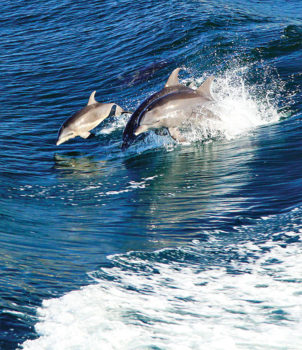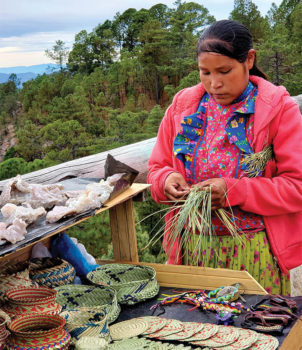
Frolicking dolphins beside our boat – Sea of Cortez.

Girl weaving basket.
Linda Nagy
A group of 29 SaddleBrooke tour participants, including my husband and me, just returned from a fun-filled, educational week-long bus tour to Northwestern Mexico and Copper Canyon region. We boarded a luxury bus in SaddleBrooke and left Monday morning, November 19 to head for the Nogales Mexican Border. After stops in Santa Ana and Hermosillo, we arrived at the resort village of San Carlos for overnight. Our rooms had stunning panoramic views over the marina and to the craggy peaks of the Tetas de Cabra Mountain.
The next morning our group took a boat excursion on the Sea of Cortez. We spotted all kinds of sea birds including brown pelicans, cormorants and blue-footed boobies, as well as their nesting places. “I loved San Carlos; we stayed at a beautiful resort,” said Bill Johnson, “and I especially enjoyed seeing all the waterfowl and the dolphins playing and jumping in the wake of our boat.” The tour of San Carlos continued with a visit to a pearl farm and ended in the evening as we viewed a spectacular sunset. The next destination had a totally different look and appeal, Alamos. Here the streets were lined with buildings that opened into beautiful courtyards filled with fountains and exotic blooming plants. On a walking tour we learned about the history of the town and went inside many of the beautifully restored haciendas built 200 to 300 years ago. The next stop was El Fuerte for an overnight stay. Before dinner we were treated by Mayo Native Americans showing their traditional “Deer Dance.” Our tour host took several of us on a walking tour after dinner where we visited some historic hotels and a statue to the legendary El Zorro.
Early the next day our group boarded the “Chepe” train for a seven-hour scenic uphill ride through uncountable switchbacks and tunnels to the top of Copper Canyon. There, we first encountered the Tarahumara semi-nomadic Native American tribe who offered colorful weaved baskets and apples to train passengers at train stops.
We stayed for two nights at a cliff top hotel in the canyon area. Copper Canyon, Barrancas del Cobre, is a network of five canyons larger and deeper than the Grand Canyon. The first afternoon there we crossed a part of the rugged canyon by aerial tram. In the deep valleys below and rugged tree-lined terrain, we could see below the white-washed little homes of the Tarahumara that could only be reached by foot.
The next morning was sunny and all awoke to great views of the canyon. Four-wheel drive vehicles drove us to several look-out locations where young girls sold their handmade baskets and small souvenirs. Next the group left to find the elementary and boarding school where the Mexican Government provided free education for the youngsters. This was an adventure in itself. Our tour vehicles went along winding steep trails, maneuvering large rocks and crossing small streams until we arrived at the school location far away from civilization. We were shown the grounds and visited the extremely well-kept dormitories, cafeteria and school room. In the meantime, a large unicorn pinata was hung by the basketball hoop and boxes of school supplies that we had brought were laid out for the kids. They waited patiently as we made photos and then they lined up for the pinata. After some of the smaller children tried, the larger ones finally broke open the paper mâché unicorn spilling the candies and goodies that the children picked up in seconds. Afterwards, the principal divided up the donated supplies in a way that all the participating children were smiling and happy. “Seeing the children at the school was the most memorable and special moment of the whole tour” was mentioned by many of the tour participants.
We left the next morning to continue our tour from the high ridges of Copper Canyon into the high plains of Chihuahua. There are about 60,000 Mennonites in this area who still speak a low German dialect. We continued on to Nuevo Casas Grandes for our overnight stay. At dinner, our group bid on three magnificent pottery pieces that we had seen being fired earlier. The Lawsons and Horsts were the winning bidders of the fine black and white glazed ceramic pots after a robust auction from our group.
The next morning, we visited the nearby Paquime Archeological Zone, the ruins of a multi-story pueblo known as “Casas Grandes.” The culture lasted nearly 450 years until the late 14th Century. It was from the excavated pottery pieces that the residents of the nearby farming village of Mata Ortiz began re-creating pieces based on the intricate designs. Sheep farmer Juan Quezada Celado re-created the ancient pot making techniques and by the 1970s taught his family and friends. By the 1990s, these pottery pieces were being recognized for their aesthetic value and sold in museums and fine galleries in the US.
Now over 300 potters in Casas Grandes region are producing fine art pottery pieces. Our group had the opportunity to purchase some of them at the Paquime Archeological Museum and at a visit to a close-by home business. These pottery pots are completely formed by hand, polished, decorated with designs using long-haired brushes made with human hair, and then fired in dug-out pits covered with wood.
Soon we were on the bus again heading back across the border toward SaddleBrooke. Everyone had great experiences from the cultural and historical stops that, of course, also included fine Mexican food along the way. We purchased gifts and keepsakes, took abundant photos and made new friends and memories to last a lifetime. Tired but happy, we said our goodbyes to tour host, Sergio, and bus driver, Francisco, of A Closer Look Tours of Phoenix.
Linda and Bernie Nagy are residents of SaddleBrooke and long-time travel writers, publishers and photographers.
